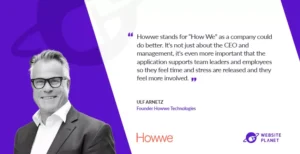Companies often spend a lot of time developing a strategy but significantly less time implementing it. As a result, the goals in the strategy are rarely achieved. You’ve probably heard it more than once: “A mediocre strategy well executed is better than a brilliant strategy poorly executed.” You might even have said it yourself to make a point.
Successfully achieving goal setting in a strategy is not easy. The nature of goals is that they are set high, and a CEO’s challenges regarding goal setting differ from those of an employee. The CEO has the overall responsibility of ensuring that the company succeeds in the plans it has promised the board, owners, and employees. Many companies have high goals related to financial performance but struggle to achieve them on time.
“A problem we often encounter is that the process of developing a concrete and actionable strategy and business plan for everyone within a company takes too long,” says Katarina Bennich, Chief Marketing Officer at Howwe Technologies, which develops an enterprise execution software that helps companies achieve their most critical goals faster and more safely with its software, Howwe®.
Many business leaders she meets experience difficulties in communicating and anchoring the plan through the management group, functional managers, and throughout the organization, so that everyone understands and is involved. Therefore, it is challenging for employees to contribute as they don’t know what to do or why to do it. As a results, much of the power in the companies remains unleashed.
Implementation is not prioritized
The development of the strategy is often given a high priority, and many companies hire external management consultants to develop a strategy and set goals for the company.
“However, just having a strategy does not create results. A strategy creates value only when it is implemented and its goals are achieved. Implementing the strategy is difficult and tends to be lower on the priority list for companies, and this is a contributing factor to why the initiatives in the strategy are rarely achieved,” says Katarina Bennich.
In practice, plans often get stuck in analog PowerPoint documents or Excel. “The consequence is all too often that the strategy gets stuck at the management level, not broken down into activities that employees can execute, and ultimately the company’s most important goals are not achieved on time.
New times require modern tools
Katarina Bennich notes that a significant challenge is to communicate the plan clearly and how it will be realized without the right tools. In addition, it is challenging to get an accurate picture of how the plans are going and involve, motivate, and confirm employees.
“The need for modern and customized tools has increased. It is a necessity to create an understanding of the goals, to successfully convert the goals into actionable activities, and to unite employees behind the goals if you are to have a chance of getting them on board fast enough when the goals change, which they often do.
She argues that with modern technology and customized software for accelerated strategy execution, employees at all levels of the company can be involved and have the opportunity to contribute to achieving the goals in the company’s strategy within the set calendar time.
“Running a finance department without an accounting system or a sales department without a CRM system is almost unthinkable today. A software to support a the execution of the strategy creates increased opportunities for accelerated growth.”
A health check of organizations’ underlying performance capability
Howwe has now developed a new analysis tool, Assessment™, to help CEOs get a better understanding of the organization’s strengths, weaknesses, and financial potential to give them better conditions to succeed with their goals. It is a process that takes only half an hour. Sign up to do an Assessment™ free of charge.
“By answering 30 questions, the CEO maps the company’s organizational strengths and challenges as well as the CEO’s individual conditions as a leader for the organization. Factors that affect the opportunities to achieve the goals in the company’s strategy.
Assessment™ has been developed based on research from, among others, Gartner, McKinsey, and data from thousands of teams in the enterprise execution software Howwe. Based on the answers in the Assessment™, a report is generated that shows what conditions an organization has to succeed in implementing a change process and what outcome a CEO can expect based on the current situation.
The report is a first step on the journey to making a strategy actionable, concludes Katarina Bennich.
The analysis of all completed Assessments™ shows that many business leaders feel that the strategy work gets stuck already at the executive level, making it difficult for functional managers to take the baton and manage change downward in their respective organizations.
5 tips on how a CEO can speed up the execution of the strategy
- Create clarity around the goals in the strategy so that all employees understand what needs to be done and why – and how they can contribute.
- Break down the three-year strategy into a concrete business plan that you can act on already in the current quarter.
- Keep the strategy alive, otherwise it quickly becomes secondary for both the CEO and employees, leading to a loss of focus and time and a postponement of milestones.
- Set aside time for strategic work. Without dedicated focus on strategic initiatives, it will drown in the operational whirlwind.
- Ensure that you have your executive team behind the company’s priority initiatives. Otherwise, the risk is high that the strategy will get stuck already at the executive level, delaying the anchoring and, above all, the execution compared to the original plan.





